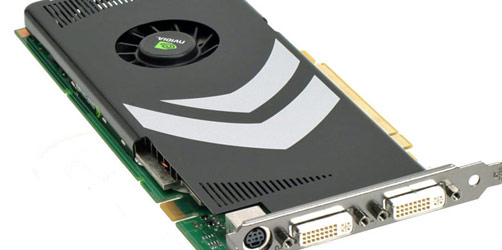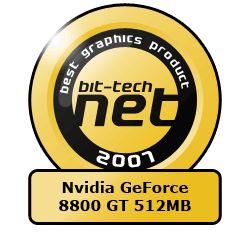The bit-tech Hardware Awards 2007
December 19, 2007 | 08:58

Best Graphics Card: Nvidia GeForce 8800 GT
Notable Mentions: AMD ATI Radeon HD 3870 512MB, BFGTech GeForce 8800 GTX WaterCooled EditionEver since the launch of Nvidia’s GeForce 8800 GTX in November of last year, it feels like the graphics industry has suffered from a quite large hangover for most of this year, with the large majority of launches only delivering disappointment after disappointment.
Before the slew of disappointments started though, BFGTech delivered an awesome watercooled GeForce 8800 GTX that really (and we mean, really) impressed us. Of course, it was expensive and out of the reach of all but the most extreme enthusiasts, but it was nevertheless an incredible product.
And that was when the hangover started...
The headache hit us pretty hard when Nvidia launched its so-called ‘mid-range’ GeForce 8600- and 8500-series products. The launch left us well and truly underwhelmed as the new products were nowhere near as fast as they should have been. That was largely down to the fact that the GPUs powering the products just didn’t have enough grunt – 32 stream processors for a supposed mid-range product when the high-end product has more four times the processing power?
Right from the outset, we never managed to understand that one and as a result, we continued to recommend ATI’s Radeon X1950 Pro—one of the stars from last year—and Nvidia’s GeForce 7900 GS for those of you that are firmly rooted in the Nvidia camp.
Following this, we then had the bizarreness that was R600 – a GPU packed to the gills with cool technologies, but when combined together it left us almost as disappointed as we were when Nvidia’s mid-range products launched. It was as if AMD had a duff mixing spoon, because the product grossly under delivered and we were left with a product that had the potential to be faster than the GeForce 8800 GTX, but rarely surpassed the cheaper and less powerful GeForce 8800 GTS 640MB.

We then reached an all-time low when the Radeon HD 2600-series launched because, again, the cards weren’t fast enough for gamers and like R600, they turned out slower than the competition from Nvidia... which was already pretty poor in its own right. We didn’t think we’d be in a situation where an incredibly underwhelming product would actually be made to look better by the competition’s answer that was even worse.
That said, there were some cool technologies inside the HD 2600 and HD 2400 series cards and, as a Home Theatre PC solution, they (collectively) weren’t all that bad. The problem for both AMD’s and Nvidia’s so-called mid-range products though was that a huge part of the marketing was about the card’s DirectX 10 capabilities – something that was later found out to be nothing more than a check box feature that you’d never ever be able to use.
It got to the stage where the graphics industry was actually becoming a rather boring place to be. In fact, it wasn’t until Nvidia launched its excellent GeForce 8800 GT that there was a graphics product launched in 2007 that was actually worth writing home about. And boy, what an incredible treat we were given.

Not only did Nvidia manage to reduce all of AMD’s Radeon HD 2000-series product line to tears, it also managed to condense Nvidia’s own product line to just two graphics cards: the GeForce 8800 GT and the GeForce 8800 GTX for those with higher-resolution monitors. It wasn’t worth considering anything else in the company’s line up, because it was either completely underwhelming (ala ‘mid-range’ GeForce 8600/8500 cards), outperformed by the GeForce 8800 GT at a lower price point (the GeForce 8800 GTS 320MB and 640MB cards) or completely overpriced (the GeForce 8800 Ultra).
 AMD had been misfiring all year and it wasn’t until November that it came up with a product that was really worth recommending to all but the die-hard AMD/ATI stalwarts. Even though AMD didn’t manage to outperform Nvidia’s GeForce 8800 GT, the Radeon HD 3870 is a great card at the right price and in many ways, it’s actually very tempting to pocket the difference and put up with slightly lower performance.
AMD had been misfiring all year and it wasn’t until November that it came up with a product that was really worth recommending to all but the die-hard AMD/ATI stalwarts. Even though AMD didn’t manage to outperform Nvidia’s GeForce 8800 GT, the Radeon HD 3870 is a great card at the right price and in many ways, it’s actually very tempting to pocket the difference and put up with slightly lower performance.There was more to the card than gaming performance though, because AMD implemented some very innovative power management features that we want to see a lot more of during 2009 – it’s about time we had more CPU-like power management features available on GPUs, as they now represent the biggest single power drain in most high-end systems.
Although we haven’t published our review of the Radeon HD 3850, it’s another product that looks to be an impressive one for the price. And that’s to such an extent that it forced Nvidia to quickly paper launch the GeForce 8800 GT 256MB in order to make its product line look a little better than it did post Radeon HD 3850 launch.

MSI MPG Velox 100R Chassis Review
October 14 2021 | 15:04








Want to comment? Please log in.